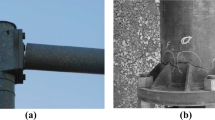Abstract
Large amplitude vibration of mast arm structures due to wind loads are the primary contributing factor to the reduced fatigue life of signal support structures. To alleviate this problem of wind-induced in-plane vibration of mast arm signal structures, a particle-thrust damping based turned mass damper (PTD-TMD) device is adopted and its damping effect is characterized experimentally. The particle-thrust damping is a passive damping device that does not require electric power and is temperature independent. Based on the calibration test, an equivalent dynamic model of the PTD-TMD device is developed and used for numerical simulation study. The damping effects of this PTD-TMD device on signal support structures was investigated through both numerical analysis and laboratory testing of a 50-ft (15.24 m) mast arm structure including both free vibration and forced vibration tests. The experimental test and numerical study results show that vibration response behavior of mast arm signal support structures can be significantly reduced by installing the PTD-TMD that can increase the critical damping ratio of the mast arm signal structures to 4%. The stress range at the welded connection between the mast arm and traffic pole is also reduced.
Similar content being viewed by others
References
AASHTO (2009), Standard Specifications for Structural Supports for Highway Signs, Luminaires and Traffic Signals, Fifth Edition, Chapter 11.
Albert MN, Manuel L, Frank KH and Wood SL (2007), “Field Testing of Cantilevered Traffic Signal Structures Under Truck–Induced Gust Loads”, FHWA/TX–08/0–4586–2, Center for Transportation Research, University of Texas at Austinz.
Alderson JL (1999), “Fatigue Study of Cantilevered Traffic Signal Mast Arms”, PhD Dissertation, University of Missouri–Columbia, Columbia, Missouri.
ANSYS (2016), ANSYS Academic Research, Release 16.2, Pittsburgh, Pennsylvania.
Chen G, Wu J, Jiaqing Yu (2001), “Fatigue Assessment of Traffic Signal Mast–arms Based on Field Test Data under Natural Wind Gusts,” Transportation Research Record: Journal of the Transportation Research Board, 1770: 188–194.
Chopra AK (2012), Dynamics of Structures, 4th Edition, Prentice Hall, Upper Saddle River, New Jersey, USA.
Christenson R, Cashany M, Hua J and Zuo D (2014), “Field Testing of Signal Head Vibration Absorber to Reduce Fatigue in Wind–Excited Traffic Signal Support Structures,” Transportation Research Record: Journal of the Transportation Research Board, 2406: 42–48.
Christenson R and Hoque S (2001), “Reducing Fatigue in Wind–Excited Support Structures of Traffic Signals with Innovative Vibration Absorber,” Transportation Research Record: Journal of the Transportation Research Board, 2251: 16–23.
Cook RA, Bloomquist D, Richard D and Kalajian MA (2001), “Damping of Cantilevered Traffic Signal Structures,” ASCE Journal of Structural Engineering, 127(12): 1476–1483.
Cook RA, Bloomquist D, Kalajian MA and Cannon VA (1998), “Mechanical Damping Systems for Traffic Signal Mast Arms,” Report WPI 0510775, Engineering and Industrial Experiment Station, University of Florida, Gainesville.
Dexter RJ and Ricker MJ (2002), “Fatigue–Resistant Design of Cantilevered Signal, Sign, and Light Supports,” NCHRP Report 469, Washington, DC: Transportation Research Board of the National Academies.
Fouad FH, Davidson JS, Delatte N, Calvert EA, Chen S, Nunez E and Abdalla R (2003), “Structural Supports for Highway Signs, Luminaires, and Traffic Signals,” NCHRP Report 494, Washington, DC: Transportation Research Board of the National Academies.
Gilani A and Whittaker A (2000a), “Fatigue–Life Evaluation of Steel Post Structures. I: Background and analysis,” ASCE Journal of Structural Engineering, 126(3): 322–330.
Gilani A and Whittaker A (2000b), “Fatigue–Life Evaluation of Steel Post Structures. II: Experimentation,” ASCE Journal of Structural Engineering, 126(3): 331–340.
Hamilton HR, GS Riggs and JA Puckett (2000), “Increased Damping in Cantilevered Traffic Signal Structures,” ASCE Journal of Structural Engineering, 126(4): 530–537.
Hartnagel BA and Barker MG (1999), “Strain Measurements on Traffic Signal Mast Arms,” Proc. ASCE Structures Congress, New Orleans, LA, 1111–1114.
Heeden A (1999), “Fatigue Evaluation of the Mast–Armto–Pole Connection in Traffic Signal Structures using Finite Element Analysis,” Master’s Thesis, Department of Civil Engineering, University of Kansas.
Kaczinski MR, RJ Dexter and JP Van Dien (1998), “Fatigue–Resistant Design of Cantilevered Signal, Sign, and Light Supports,” NCHRP Report 412, Washington, DC: Transportation Research Board of the National Academies.
Kashar L, Nester M, Jones J, Hariri M and Friezner, S (1999), “Analysis of the Catastrophic Failure of the Support Structure of a Changeable Message Sign,” Proceedings of the Structures Congress, 1115–1118.
Koenigs MT (2003), “Fatigue Resistance of Traffic Signal Mast–Arm Connection Details,” PhD Dissertation, University of Texas at Austin.
Li Z and Zhang Y (2014), “Fatigue Life Prognosis Study of Welded Tubular Joints in Signal Support Structures,” International Journal of Steel Structures, 14(2): 281–292.
McManus PS, HR Hamilton III and JA Puckett (2003), “Damping in Cantilevered Traffic Signal Structures under Forced Vibration,” ASCE Journal of Structural Engineering, 129(3): 373–382.
Ocel JM, Dexter RJ and Hajjar JF (2006), “Fatigue–Resistant Design for Overhead Signs, Mast–Arm Signal Poles, and Lighting Standards,” No. MN/RC–2006–07, St. Paul, MN: Minnesota Department of Transportation.
Shah BM, Pillet D, Bai XM, Keer LM, Wang QJ and Snurr RQ (2009), “Construction and Characterization of a Particle–based Thrust Damping System,” Journal of Sound and Vibration, 326(3): 489–502.
South Jeffrey M (1997), “Fatigue of Tube–to–Plate Fillet Welds and Methods for Their Improvement,” No. FHWA/IL/PR–118.
Veeramuthuvel P, Shankar K and Sairajan KK (2017), “Application of RBF Neural Network in Prediction of Particle Damping Parameters from Experimental Data,” Journal of Vibration and Control, 23(6): 909–929.
Acknowledgement
The work described in this paper was partially supported through a research grant from Maryland State Highway Administration (MdSHA) and National Transportation Research Center at University of Maryland. The assistance of Dr. Chung C. Fu and staff members of MdSHA with the mast arm structure specimen is greatly appreciated. However, the opinions and conclusions expressed in this paper are solely those of the writers and do not necessarily refl ect the views of the sponsors.
Author information
Authors and Affiliations
Corresponding author
Rights and permissions
About this article
Cite this article
Zhang, Y., Liu, H. Experimental study of vibration mitigation of mast arm signal structures with particle-thrust damping based tuned mass damper. Earthq. Eng. Eng. Vib. 18, 219–231 (2019). https://doi.org/10.1007/s11803-019-0500-2
Received:
Accepted:
Published:
Issue Date:
DOI: https://doi.org/10.1007/s11803-019-0500-2




